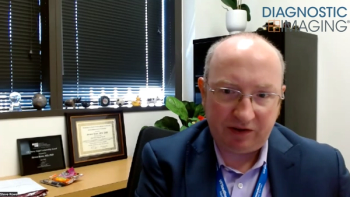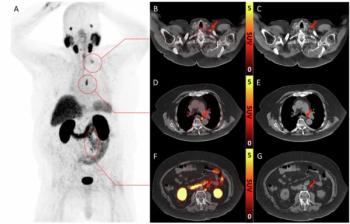Vectorial Analysis in Radiology: Assessing Direction and Momentum
With dramatic changes less likely with respect to reimbursement and one’s career in radiology, have we downsized our expectations to be more accepting of a floor of stability and slow progress?
One of the challenges of early med school is that much of the massive volume of learning material doesn’t feel particularly doctorly. While it is relevant, it still feels like you’re cramming information into your noodle just for the sake of proving you can, and maybe some of it will have use after passing exams. Accordingly, when something turns up that has more clear-cut clinical value, most students sit up and pay eager attention.
Electrocardiograms (ECGs) are a good example. What prospective doc doesn’t imagine being able to look at those little squiggles of ink and make brilliant pronouncements about the heart? My class was therefore more than a little disappointed when the prof who was supposed to be teaching the subject proved to be far from enthusiastic. He seemed inclined to avoid it entirely.
Make me think you’re withholding knowledge from me — especially on the grounds of it possibly being too difficult to grasp — and you will skyrocket my interest in it. I can imagine a shrewd teacher intentionally using such a reverse psychology tactic, but that particular member of faculty wouldn’t have had it in him.
When the prof blatantly told us he wouldn’t be going into “vectorial analysis” of ECGs, I made it a personal mission to learn the stuff. Not-so big surprise: Other than netting me an exam question or two down the line, it wasn’t a big surprise that I never actually used the skills for cardiology in my subsequent rad career.
Nevertheless, I first learned about vectors in grade school, and it was nice to see them used in the real world. The more things like that tickle one’s brain, the more ways one finds to use their concepts. Lest you’re rusty or entirely unfamiliar, a vector has magnitude and direction. That can be electrical current in a heart (hence relevance to ECGs), velocity of a car or even weight of an object (the direction being downward toward the planet’s center).
My usage of vectors has been more on a conceptual, even philosophical level, rather than number crunching. I don’t consciously think of them as vectors but more like trends or tendencies. I might also refer to it as knowing which way the winds are blowing as well as how they might shift.
One example with which most rads are probably familiar is the financial value of an imaging study. In the fullness of time, adjusting for things like inflation and overhead, we get paid less per unit work than we used to. (By “we,” I mean radiology as a whole within the CMS/insurance-controlled marketplace. Individually, one might buck that trend by maneuvers such as changing jobs.) The vector of reimbursement per study has decreased with the magnitude of descent varying from year to year.
I regard such vectors/trends as things that are likely to continue as they have until they encounter some reason not to go in that particular direction. This borrows another concept from early education: inertia. We might hope that, someday, the work we do will be valued more highly. More realistically, we might at least expect that the value imposed on radiology work will reach a “floor” somewhere above zero.
However, something generally has to exert an influence on a vector for it to change. Fervent wishes or complaints don’t generally work. One might debate whether pressure brought to bear by entities such as the ACR does much better. It’s possible that a sufficient number of med students might at some point decide that radiology is no longer a viable career choice, and “vote with their feet.” The resulting shortage, if sufficient, could perhaps make something happen.
Sizing all that up, I have concluded that I shouldn’t expect the trend to reverse any time soon if ever. The best I hope for is that things stabilize or don’t accelerate downward, at least during the remainder of my career. Certainly, I don’t expect any cavalry to charge over the hill and suddenly rescue us all.
On a much smaller scale, individual level, I have applied similar thinking to circumstances in places I have worked. For instance, I have written in a previous blog about the second post-fellowship job I held that was supposed to have a four-year partnership track. When the time came, they gave lip service. They would talk to their lawyers and accountants to get things ready, etc. But time moved by, and things never seemed to progress. I gradually shortened the intervals between inquiries, but it became obvious. There was no momentum. By the time they did get around to detailing their sham of “partnership,” its complete lack of value was no surprise at all.
A similar drama played out in a more recent job. Being a bit older and wiser, I didn’t wait five years to bail out this time. The gig had begun looking beautiful on paper with an acknowledgement that the actual nuts and bolts of the rad group’s infrastructure were overdue for replacement. Thus, the actual gig wouldn’t initially perform as well as it looked on paper. A timeline for new hardware/software, etc., was laid out, and rads like me willingly entered the situation because our employer convinced us there would soon be a favorable vector.
You have probably guessed that never actually materialized. Every time something was supposed to happen, it did not. Things got postponed or retracted entirely. Despite lip service of a vector with good directionality and magnitude, the actuality was stagnation. Similar to the CMS/insurance stranglehold situation on health care I mentioned above, I increasingly saw no reason to believe a positive vector would spontaneously emerge from the flatline of reality. Indeed, some backwards steps started to creep in, and I had no reason to believe that would reverse itself.
Here is one last thought. I avoid a rush to judgment if I see things going slower than I had hoped. Direction is far more important than magnitude. Slow progress is infinitely better than none at all. It shows at least some degree of a good faith effort by whatever other players are involved, and that circumstances are allowing movement toward my goal. I can tolerate taking longer to get there.
Newsletter
Stay at the forefront of radiology with the Diagnostic Imaging newsletter, delivering the latest news, clinical insights, and imaging advancements for today’s radiologists.































